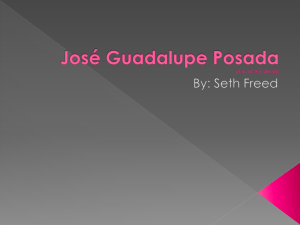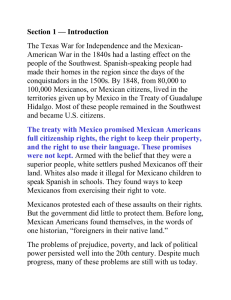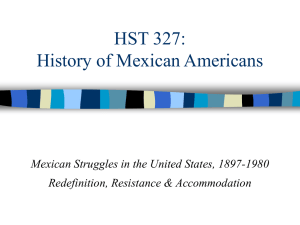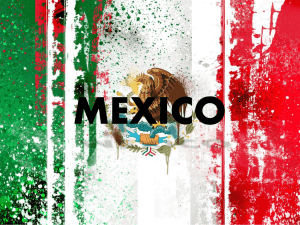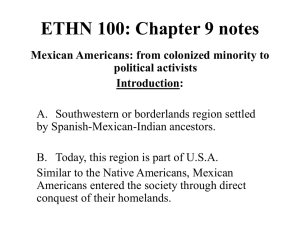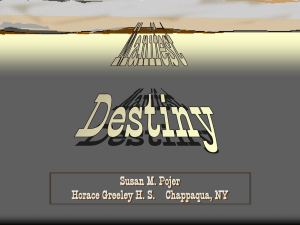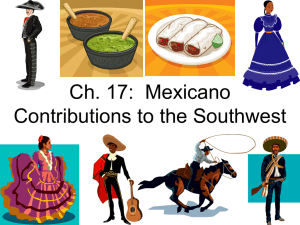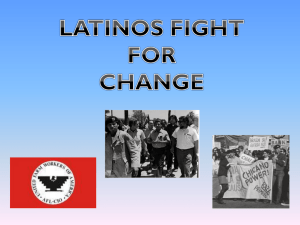File
advertisement
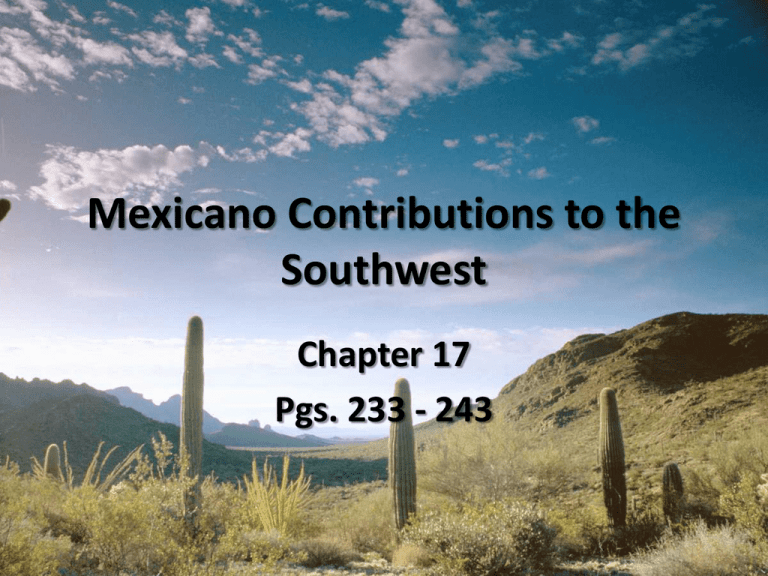
Mexicano Contributions to the Southwest Chapter 17 Pgs. 233 - 243 17.1 Introduction • The United States adopted many things from the Mexican heritage • Heritage (tradition)- something that is passed down from previous generations 17.2 Mexicano Mining Contributions Gold Mining: Mexicans gave Americans the: • Batea: The gold pan • Riffle box: Separated mud and gold • Arrastra: Crushed rocks so gold could be removed 17.2 Continued… Silver and Copper Mining: • Henry Comstock found silver in Nevada • Americans looked for Mexicans for help when they mined for copper in Arizona 17.3 Cattle Ranching • Cattle were very thin with long horns The Rancho: • The main products produced on Ranchos were: meat hides and tallow (lard) • Vaqueros (Cowboys) worked there 17.3 Continued… The Roundup: • Vaqueros most important jobs were rodeo and branding • They branded to see and show which cattle was theirs so no one would steal them • This is still done in today’s cattle farming! 17.4 The Cowboy • American cowboys gained their skills from the Mexican Vaqueros Cowboy Clothes and Gear: • Cowboy hats = sombreros • Cowboys chaps = chaperreras • Cowboys boots = botas • Cowboys ponchos • Vaqueros created the horn on the saddle • Vaqueros also created the la riat 17.4 Continued… Cowboy Lingo: • The terms Americans Cowboys use come from Spanish Words • Example: Ranch came from Rancho Questions • Who did American cowboys gain their skills from? • Describe what Spanish cattle looked like? • What did Vaqueros do to their cattle to show that they belonged to them? • Vaquero is Spanish for what English word? • Something that is passed down from past generations is called a what? • Draw Cowgirl Buzz and label the 5 items that she got from the Mexican Vaqueros. • What were the three things that the Mexicans gave to Americans during the gold rush? • When the Spanish came to Mexico what did they find instead of gold? 17.5 Sheep Raising Two types of sheep raised: 1) Merios 2) Churros The Spanish Sheep Raising System: • Americans started raising sheep when they saw how much money could make Americans adopt the Spanish System: • Because of increased sheep raising American wool production went from 5 to 22 Million pounds of wool in 18 years 17.6 Irrigated Farming • When the farmers moved west they had to use irrigation because it did not rain as much as the East The Mexican Style of Irrigation: • They brought water from streams by creating dams • They would fill up a square of crops with water and when was filled they would make a hole to spread the water to the next square of crops 17.6 Continued… America’s Fruit Basket: • Mexicanos introduced Americans to many fruits that could not be produced in the East • Grapes, Olives, Apples, Peaches, Lemons, Limes, and Oranges 17.7 Mexican Food The Food Revolution: • Spanish came to Mexico for gold but instead found Indian Food • Corn, Tomatoes, Chocolate, Peanuts, Vanilla, Beans, Squash, Avocados, Coconuts, Sunflower Seeds, and Chili Peppers • Spain took foods from Mexico, but also brought some of theirs 17.7 Continued… A New Style of Cooking: • When they combined Spanish and Indian food came up with Mexican food • When Americans adopted Mexican food to their culture started combining it with American foods called “Tex-Mex” Questions • When farmers moved west, why did they use irrigation systems? • What were the two types of Spanish sheep? • What two types of food were combined in order to make Mexican food? • When Americans combined their food with Mexican food it became known as what? • What was the main reason that the Spanish started raising sheep? • In a paragraph explain how the Mexicano irrigation system works. 17.8 Spanish-style Architecture • Homes were created to suit hot, dry climates of Southwest Adobe Building: • Wood was hard to get a hold of so used adobe bricks • Adobe: mixture of earth, grass, and water baked in the sun • Covered homes with red clay tiles • Most homes had a patio and a veranda • Newcomers adopt the Spanish Style 17.8 Continued… Advantages of Adobe Houses: • Cooler in summer and warmer in winter • Can be made from local materials • 1930’s nearly 1 million adobes were made • Homes, court-houses, trading post, and post offices 17.9 Mexican Laws • American Legal tradition came from English Law • Mexicano Legal tradition came from Spanish Law Mining Law: • Because of all of the miners, America came up with the “laws of the mines” based on the Mexican mining laws • These laws moved throughout America 17.9 Continued… Water Law: • East Law: Water that was on a farm or moved through a farm was that farmer’s water and could be used anyway they wanted • Mexican/West Law: water belonged to everyone and anyone could use it 17.9 Continued… Community Property Law: • East Law: Anything that a woman “owned” belonged to her husband • Mexican/West Law: “Community Property” anything that a couple owns will be split in half if that couple separates • This law still is in most Western U.S. States 17.10 Mexicano Entertainments Music and Dancing: • Mexicano music influenced country and western music in the Southwest • Most important influence was the Corridor (A dramatic story accompanied by guitars) • Mexican dances have also influenced America ( La Bamba, Fanadango, and Jota) 17.10 Continued… Fiestas and Rodeos: • Largest religious fiesta is the one that honors Our Lady of Guadalupe, the patron saint of Mexico • Largest celebrated holiday is El Cinco de Mayo (the Fifth of May) • Rodeos are a big part of Mexican tradition and that has also spread into American culture Questions • What is the largest celebrated holiday in Mexico? • In order to make an Adobe brick, what three materials are needed? • What are the two advantages of an Adobe house? • Adobe homes were created to suit what types of climates in the Southwest? • Who have Mexican dances influenced? • The Largest Religious holiday in Mexico is to honor Our Lady of what? • In a paragraph please explain the difference between the Water Laws in the East and the Mexican /West. • In a paragraph please explain the difference between the Community Property Laws in the East and the Mexican/West.


